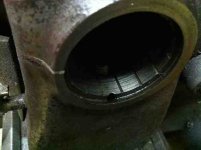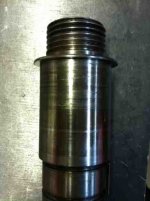TooManyProjects
Plastic
- Joined
- Jul 2, 2009
- Location
- Rochester Hills, MI
Haven't been around here in a long time...not because I don't like you guys, just that my 9" South Bend has been so reliable that I haven't had any need 
I've searched quite a bit but can't seem to find any answers. The bearing closest to the chuck on the spindle/headstock is scored pretty good. I was letting a friend of mine use the lathe when I saw & heard it come to abrupt stop. He was just taking a light cut on a piece of nylon so I knew something wasn't right. It was seized tight, so I disassembled the headstock & saw that the bearing surface was pretty scored & worn. The spindle has a little galling on it but I think it's save able.
So my question is what fixes are there for the bearing? I haven't seen replacement bearings? Being that these lathes don't have bearing caps like the larger lathes are they even serviceable? Can it be bored out & pressed with a new bearing?
Here's a couple pics of the wear


I've searched quite a bit but can't seem to find any answers. The bearing closest to the chuck on the spindle/headstock is scored pretty good. I was letting a friend of mine use the lathe when I saw & heard it come to abrupt stop. He was just taking a light cut on a piece of nylon so I knew something wasn't right. It was seized tight, so I disassembled the headstock & saw that the bearing surface was pretty scored & worn. The spindle has a little galling on it but I think it's save able.
So my question is what fixes are there for the bearing? I haven't seen replacement bearings? Being that these lathes don't have bearing caps like the larger lathes are they even serviceable? Can it be bored out & pressed with a new bearing?
Here's a couple pics of the wear




